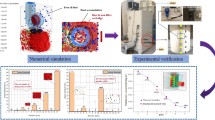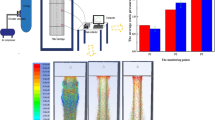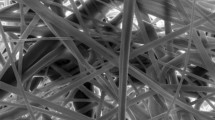Abstract
The filter cartridge dust collector has been widely used in industry, but the influence of its internal structure on its operation effects is rarely studied. FLUENT software was used to simulate the influence of different air volume and permeability values on the gas–solid two-phase flow of dust removal characteristics for a filter cartridge. The results show that when the air volume of the fan was greater than 1600 m3/h, the increase in the dust reduction rate was not obvious, and the high-velocity airflow filled the entire dust removal chamber, which was conducive to the filter using the largest effective filtration area to remove dust; the optimal air volume was 1600 m3/h. Furthermore, the dust removal effect gradually became worse when the porosity was higher than 0.65, but the fluidity of the internal air was poor when it was lower than 0.65. The optimum porosity was 0.65. A simulated validation analysis was conducted using the above optimal parameters. As the proportion of particles below 2 μm increased, the dust removal effect worsened.




















Similar content being viewed by others
Data availability
Not applicable.
Abbreviations
- ρ :
-
Density of gas (kg m−3)
- k :
-
Kinetic energy
- ε :
-
Turbulent energy dissipation rate
- μ :
-
Laminar viscosity coefficient
- μ t :
-
Viscosity coefficient
- G k :
-
The generation term of the turbulent kinetic energy due to the average velocity gradient
- a,b :
-
Generation term of the turbulent kinetic energy k caused by the mean velocity gradient and buoyancy
- y :
-
Contribution of pulsating expansion in compressible turbulence
- d,e,f :
-
Empirical constants are 1.44, 1.92, and 0.09, respectively
- m,n :
-
Prandtl numbers corresponding to the turbulent kinetic energy k and dissipation rate, respectively, and they have values of 1.3 and 1.0
- m p :
-
Particle mass
- u p :
-
Particle velocity
- ∑F :
-
Combined forces of particles
- F d :
-
Resistance to particles
- F g :
-
Particles are subject to gravity
- F f :
-
Buoyancy of particles
- F x :
-
Other forces on the particles (N), including Magnus lift, Saffman lift, additional mass, Brown force, and thermophoresis
- C d :
-
Drag coefficient
- C φ :
-
Dynamic shape coefficient
- A p :
-
Particle air ward area
- Re p :
-
Reynolds number for spherical particles
- a 1,a 2,a 3 :
-
Constants for a certain range of Reynolds number
- d p :
-
Particle diameter
- ζ :
-
Random numbers subject to a normal distribution
- \( \sqrt{{\overline{u}}^{\hbox{'}2}} \) :
-
Root mean square of fluctuating velocity
- D :
-
Parcel diameter
- ρ :
-
Particle mass density
- ν :
-
Relative velocity between two colliding particles
- ε D :
-
Fraction of the diameter for allowable overlap
- ΔP :
-
Pressure drop
- L α :
-
Permeability
- ν:
-
Normal velocity
- C :
-
Pressure jump coefficient
- ρ :
-
Fluid density
- ΔM :
-
M thickness
- D p :
-
Average pore diameter of filter material
- ε :
-
Porosity of filter material
- F(d):
-
The cumulative distribution of the particle size
- D :
-
Median diameter (μm)
- S :
-
Propagation coefficient
References
Aroussi A, Simmons K, Pickering SJ (2001) Particulate deposition on candle filters. Fuel 80(3):335–343
Cai P, Nie W, Chen DW, Yang SB, Liu ZQ (2019) Effect of air flowrate on pollutant dispersion pattern of coal dust particles at fully mechanized mining face based on numerical simulation. Fuel 239:623–635
Chen L, Li P, Liu G, Cheng W, Liu Z (2018) Development of cement dust suppression technology during shotcrete in mine of China—a review. J Loss Prev Process Ind 55:232–242
Chen X, Ge SC, Ge F et al (2014) Study on novel micro-fog & cyclonic system for removing fine particulate. J China Saf Sci J 24(9):122–127
Choi JH, Seo YG, Chung JW (2001) Experimental study on the nozzle effect of the pulse cleaning for the ceramic filter candle. J Powder Technol 114(1–3):129–135
Croom M (1993) Effective selection of filter dust collectors
Ding JF, Zhou G, Liu D, Jiang WJ, Wei ZY, Dong XS (2020) Synthesis and performance of a novel high-efficiency coal dust suppressant based on self-healing gel. Environ Sci Technol 54(13):7992–8000
Feng GR, Liao Q, Hu SY (2018) Numerical simulation of particulate matter 2.5 distribution in a roadway, scientific reports
Gao XH, Wang YK (2017) Thoughts on prevention and treatment of pneumoconiosis in coal mines. J Shaanxi Coal Ind 36(2):135–138
Han WB, Zhou G, Gao DH, Zhang ZX, Wei ZY, Wang HT, Yang HQ (2020a) Experimental analysis of the pore structure and fractal characteristics of different metamorphic coal based on mercury intrusion-nitrogen adsorption porosimetry. Powder Technol 362:386–398
Han WB, Zhou G, Zhang QT, Pan HW, Liu D (2020b) Experimental study on modification of physicochemical characteristics of acidified coal by surfactants and ionic liquids. Fuel 266:116966
Hu SY, Liao Q, Feng GR, Huang YS, Shao H, Fan YR, Ye YB (2019) Numerical study of gas–solid two-phase flow around road-header drivers in a fully mechanized excavation face. Powder Technol 344:959–969
Jibril A, Jean M, Bilainu O, Samson B, Rosemary F (2019) Experimental evaluation of activated carbon derived from South Africa discard coal for natural gas storage. Int J Coal Sci Technol 6(3):459–477
Kanaoka C, Amornkitbamrung M (2001) Effect of filter permeability on the release of captured dust from a rigid ceramic filter surface. J Powder Technol 118(1–2):113–120
Kong B, Li ZH, Wang EY, Lu W, Chen L, Qi G (2018) An experimental study for characterization the process of coal oxidation and spontaneous combustion by electromagnetic radiation technique. J Process Saf Environ Protect 119:285–294
Li QQ (2016) Study on the ash removal performance of a flat box filter with pulse injection. D Southwest university of science and technology
Li SL, Li CT, Guo GQ, Xiao YJ, Zhang YG (2014) Numerical simulation of the influence of the number of filter bags on the internal flow field of a wing-shaped aspirated air bag dust collector. J Chin J Environ Eng 8(08):3349–3354
Li SL, Zhou G, Wang YY, Jing B, Qu YL (2019) Synthesis and characteristics of fire extinguishing gel with high water absorption for coal mines. Process Saf Environ Protect 125:207–218
Li S, Ni GH, Wang H, Xun M, Xu YH (2020a) Effects of acid solution of different components on the pore structure and mechanical properties of coal. Adv Powder Technol 31:1736–1747
Li YJ, Wang PF, Liu RH, Jiang YD, Han H (2020b) Determination of the optimal axial-to-radial flow ratio of the wall-mounted swirling ventilation in fully mechanized excavation face. Powder Technol 360:890–910
Li SL, Zhou G, Liu RL, Wang NG, Wei ZY, Liu W (2020c) Synthesis and performance characteristics of a new ecofriendly crust-dust suppressant extracted from waste paper for surface mines. J Clean Prod 258:120620
Liang S, Yang JL, Sun TC (2006) Experimental study on air flow distribution simulation of pulsed bag dust collector. J Energy Environ 02:27–30
Lin LJ, Chen HY, Zhou X, Lan M (2009) Experiment of dust-cleaning performances of pulse-jet cartridge filters, heat. Ventil. Air Cond 39:148–151
Liu Z, Wang WY, Cheng WM, Yang H, Zhao DW (2020a) Study on the seepage characteristics of coal based on the Kozeny–Carman equation and nuclear magnetic resonance experiment. J Fuel 266:117088
Liu RL, Zhou G, Wang CM, Jiang WJ, Wei X (2020b) Preparation and performance characteristics of an environmentally-friendly agglomerant to improve the dry dust removal effect for filter material. J Hazard Mater 397:122734
Ma YL, Zhou G, Ding JF, Li SL, Wang G (2018) Preparation and characterization of an agglomeration-cementing agent for dust suppression in open pit coal mining. Cellulose 25:4011–4029
Meinke P, Raether T (2002) Evolution of cartridge dust collecting technology. J Filtration Separat 39(3):24–26
Nazarboland MA, Chen X, Hearle JWS et al (2007) Effect of different particle shapes on the modelling of woven fabric filtration. J Inform Comput Sci 2(2):111–118
Ni GH, Li S, Rahman S, Xun M, Wang H, Xu YH, Xie HC (2020) Effect of nitric acid on the pore structure and fractal characteristics of coal based on the low-temperature nitrogen adsorption method. Powder Technol 367:506–516
Pereira TWC, Ribeiro DDC (2016) The influence of fabric filter layout of in a flow mass filtrate. J J Clean Prod 111:117–124
Sun L (2012) Hazards caused by haze weather and control management. Environ Sci Manag 37(10)
Tsai CJ (1996) Numerical and experimental study of cleaning process in pulse-jet fabricfiltration systems. J J Aerosol Sci 7:654
Wang G (2007) A study on internal flow field of pulse bag filter. China Metallurgical Group Building Research Institute
Wang Y (2016) Study on ash removal performance of pulsed long filter cartridge dust remover. Southwest university of science and technology
Wu MY, Hu XM, Zhang Q, Xue D, Zhao YY (2019) Growth environment optimization for inducing bacterial mineralization and its application in concrete healing. Constr Build Mater 209:631–643
Xavier S (2007) Experimental study of pulse-jet cleaning of bag filters supported by rigidrings. J Powder Technol 3.172(2):67–81
Xue XH, Sun GG, Shi MX (2007) Numerical simulation of particle concentration distribution in cycloneseparator. J Chin J Mech Eng 43(12):26–33
Yan CY, Shen HG (2015) Development of bag filter in China and its application in coal-fired power plants. J China Environ Protect Ind 5:34–36
Yang D, Chen HY, Li HY (2008) The influence of the pressure peak and pulse width on the dust-cleaning efficiency of the pulse-jet cartridge filter. J Saf Environ 5:73–76
Yin WJ, Zhou G, Gao DH (2019) Simulation analysis and engineering application of distribution characteristics about multi-stage atomization field for cutting dust in fully mechanized mining face. Adv Powder Technol 30:2600–2615
Yu HM, Cheng WM, Peng HT, Xie Y (2018) An investigation of the nozzle’s atomization dust suppression rules in a fully-mechanized excavation face based on the airflow-droplet-dust three-phase coupling model. Adv Powder Technol 29(4):941–956
Zhang MM (2015) Study on the influence of fold number of filter cartridge on the performance of pulsed filter filter. Southwest university of science and technology
Zhang DY, Wang C (2015) Manual of dust remover. Chemical industry press
Zhang YZ, Chen HY, Zheng J, Zhang MX (2010) Experiments on cleaning performance of pulsejet filter bag. J Saf Environ 3:30–34
Zhang Q, Chen HY, Ju M, Chen JD (2012) Experiment on induction nozzle improving dust-cleaning efficiency of pulse-jet cartridge filters by filters by induc-tion nozzles. Environ Eng 30(1):62–65
Zhang K, Yang JJ, Ji YN, Xia Y (2018) Spatiotemporal simulation and predication of heavy metal(loid) concentrations in coal chemical industrial areas with a soil environmental capacity model. Int J Coal Sci Technol 5(4):508–518
Zhao YJ (2008) Experimental test and numerical simulation study of the flow field distribution in the bag filter. Donghua University
Zhou QJ, Chen HY, Zhang MX, Zheng J (2011a) Influence of pulse valve injection quantity on dust-cleaning performance of cartridge filters. Heat Ventil Air Cond 41(6):100–105
Zhou QJ, Chen HY, Zhang MX, Zheng J, Wang JY (2011b) The industrial test of pulse bag filter in petroleum coke super fine grinding process. Environ Eng 29(4):94–98
Zhou G, Zhang Q, Bai RN, Fan T, Wang G (2017) The diffusion behavior law of respirable dust at fully mechanized caving face in coal mine: CFD numerical simulation and engineering application. Process Saf Environ Protect 106:117–128
Zhou G, Ding JF, Ma YL, Li SL, Zhang MG (2020a) Synthesis and performance characterization of a novel wetting cementing agent for dust control during conveyor transport in coal mines. Powder Technol 360:165–176
Zhou G, Zhang QT, Hu YY, Gao DH, Wang SC, Sun B (2020b) Dust removal effect of negatively-pressured spraying collector for advancing support in fully mechanized coal mining face: numerical simulation and engineering application. Tunn Undergr Space Technol 95:103149
Acknowledgments
This work was financially supported by the National Natural Science Foundation of China (Grant no. 51774198, 51904171), the Outstanding Youth Fund Project of Provincial Universities in Shandong Province, China (Grant no. ZR2017JL026), the Qingchuang Science and Technology Project of Universities in Shandong Province, China (Grant no. 2019KJH005), the Taishan Scholars Project Special Funding in Shandong Province, China (Grant no. ts20190935), the National Key Research and Development Program of China (Grant no. 2017YFC0805202), and the Natural Science Foundation of Shandong Province, China (Grant no. ZR2019BEE067).
Author information
Authors and Affiliations
Contributions
All authors contributed to the study conception and design. D.G., R.L., S.L., and Y.K. prepared data, experimented and analyzed. The first draft of this manuscript was written by D.G., Y.W. modeled the model, and G.Z. guided the whole process. All authors commented on previous versions of the manuscript. All authors read and approved the final manuscript.
Corresponding author
Ethics declarations
Competing interests
The authors declare that they have no competing interests.
Ethics approval and consent to participate
Not applicable. All analyses are based on previously published research. The research does not involve ethical and moral issues, so no moral approval is required.
Additional information
Responsible Editor: Marcus Schulz
Publisher’s note
Springer Nature remains neutral with regard to jurisdictional claims in published maps and institutional affiliations.
Highlights
Analysis of the airflow characteristics in the dust collector shows that the air volume is relatively optimal at 1600 m3/h.
Analysis of dust distribution rule was performed to obtain the optimal filter porosity of 0.65.
The greater the proportion of 0~2 μm dust particles, the worse the dust removal effect.
On this basis, combining filter cartridge with dry fog removal, the dust concentration below 2 μm can be effectively reduced.
Rights and permissions
About this article
Cite this article
Gao, D., Zhou, G., Liu, R. et al. CFD investigation on gas–solid two-phase flow of dust removal characteristics for cartridge filter: a case study. Environ Sci Pollut Res 28, 13243–13263 (2021). https://doi.org/10.1007/s11356-020-11334-6
Received:
Accepted:
Published:
Issue Date:
DOI: https://doi.org/10.1007/s11356-020-11334-6




